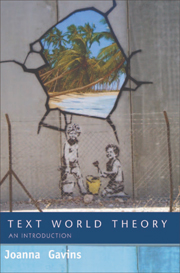9 - Double-vision
Published online by Cambridge University Press: 05 August 2013
Summary
KEY ISSUES IN THIS CHAPTER
This is the final chapter in this book to explain a specific aspect of the Text World Theory framework, before Chapter 10 moves on to explore some of the directions the text-world approach to discourse study as a whole might take in the future. The discussion in the present chapter concerns the conceptualisation of a particular linguistic and cognitive phenomenon: metaphor. Metaphor has received an enormous amount of attention from cognitive linguists and psychologists in recent years. Indeed, a new understanding of the conceptual properties of metaphor was the main driving force behind the cognitive revolution in linguistics from the 1980s onwards. This chapter begins with a summary of some of the most recent theories of metaphor to emerge from Cognitive Linguistics, alongside some typical single-sentence examples of how metaphor is processed in the mind. However, Text World Theory's encompassing and discourse-focused approach means that the extension of metaphor through longer texts, and sometimes throughout entire discourses, is of greater interest to text-world theorists. This phenomenon is examined in the later sections of the chapter. Poetry provides some obvious and useful examples on which to base an initial discussion of metaphor, though both literary and non-literary texts are analysed here. The chapter also includes an exploration of metaphorical constructions in non-literary discourse, and a range of examples of the same sort of lonely-hearts advertisements with which this book opened is examined.
- Type
- Chapter
- Information
- Text World TheoryAn Introduction, pp. 146 - 164Publisher: Edinburgh University PressPrint publication year: 2007



